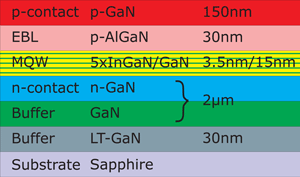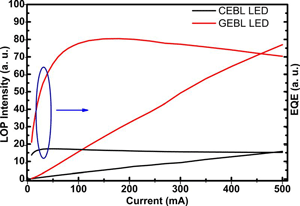- News
16 February 2012
Green LEDs benefit from graded blocking
Researchers in China have applied graded electron-blocking layers (GEBLs) to increase the light output powers of green light-emitting diodes (LEDs) by up to 415% at a drive current of 350mA [Ning Zhang et al, Appl. Phys. Lett.. vol100, p053504, 2012]. The onset of efficiency droop was also delayed to 150mA, compared with 50mA for a conventional device.
Conventional electron-blocking layers (CEBLs) of aluminum gallium nitride (AlGaN) are often used in nitride semiconductor LEDs to avoid electrons overshooting the active light-emitting layers. Electrons that overshoot the active region reduce the light emission efficiency by reducing hole injection into the active region.
However, AlGaN blocking layers introduce their own problems. One problem is that, while the electrons are blocked as desired, holes are also blocked to some extent. Another is that the lattice mismatch between AlGaN and the indium gallium nitride (InGaN) quantum wells and GaN barriers introduces large levels of strain.
Nitride semiconductors are highly piezoelectric, which means that strains produce large polarization fields that, in turn, set up electric fields in the active region. These electric fields tend to make it more difficult for electrons and holes to recombine and produce light (the quantum-confined Stark effect, or QCSE).
Last year, Taiwan researchers used GEBLs to improve performance of blue-LEDs [Good grades for reducing nitride LED efficiency droop]. The new research on the more challenging longer-wavelength green range was carried out by the Chinese Academy of Sciences’ (CAS) Research and Development Center for Semiconductor Lighting in Beijing.
 The CAS researchers used a Veeco metal-organic chemical vapor deposition (MOCVD) system to create LEDs with 30nm conventional or linearly graded EBLs consisting of p-type AlGaN with 20% or 0-20% Al, respectively. The growth was in the c-direction (0001) on sapphire substrates. The full structure (Figure 1) included a pre-strain region of two pairs of InGaN/GaN layers and an active region with five quantum wells of InGaN with GaN barriers.
The CAS researchers used a Veeco metal-organic chemical vapor deposition (MOCVD) system to create LEDs with 30nm conventional or linearly graded EBLs consisting of p-type AlGaN with 20% or 0-20% Al, respectively. The growth was in the c-direction (0001) on sapphire substrates. The full structure (Figure 1) included a pre-strain region of two pairs of InGaN/GaN layers and an active region with five quantum wells of InGaN with GaN barriers.
Figure 1: Schematic of GEBL (graded Al content from 0% to 20%) and CEBL (20% Al) devices.
The LED mesa structures were 580μm x 250μm. Indium tin oxide (ITO) transparent conducting layers were deposited on the n- and p-GaN contact layers. The metal electrodes consisted of chromium/gold.
Photoluminescence and x-ray diffraction analysis suggested that the polarization field in the QWs was reduced in the GEBL device. For example, the photoluminescence peak is blue-shifted from 522.4nm in the conventional LED to 518.6nm in the GEBL device.
At 20mA current injection, the GEBL device demonstrates 130% increased peak intensity over the conventional LED. The researchers mainly attribute the increased peak intensity of the GEBL LED to lower polarization fields.
Increased current generally shifts the emission peak in nitride LEDs due to various effects. The shift in the GEBL device is lower than in the conventional LED – in the range 10-130mA, the shifts are 5.8nm and 9.6nn for the GEBL and CEBL LEDs, respectively. It is common in nitride LEDs for radiative recombination to be concentrated in the last well before the EBL (if present) and the p-contact layers. The effect of using a GEBL mainly affects the last well, improving conditions for radiative recombination and thereby reducing strain and hence the piezoelectric polarization field.
The forward voltage at 20mA is reduced by 0.38V in the GEBL LED. The researchers comment: “The polarization field in the active region produces large triangular barriers that hinder carriers flowing, across which a higher bias must be applied for carriers to flow. For the GEBL LED, the height of the triangular barriers in the valence band is reduced because of the lower polarization field and thereby the hole injection from one well layer to an adjacent well layer is enhanced.”
 The researchers also see the improved forward voltage as being due to improved hole injection due to a modified energy band structure in the GEBL material.
The researchers also see the improved forward voltage as being due to improved hole injection due to a modified energy band structure in the GEBL material.
Figure 2: Light output power (LOP) and external quantum efficiency (EQE) versus current for LEDs with CEBL or GEBL.
The light output power for the GEBL LED is increased by 163% at 20mA and 415% at 350mA, respectively, over the conventional device (Figure 2). The peak of external quantum efficiency (EQE) is delayed to 150mA, compared with the conventional device’s 50mA.
Grading barriers for improved hole transport
Good grades for reducing nitride LED efficiency droop
Varying wells to combat LED efficiency droop
Green LEDs Graded electron-blocking layers InGaN/GaN AlGaN GaN LED efficiency droop
The author Mike Cooke is a freelance technology journalist who has worked in the semiconductor and advanced technology sectors since 1997.
